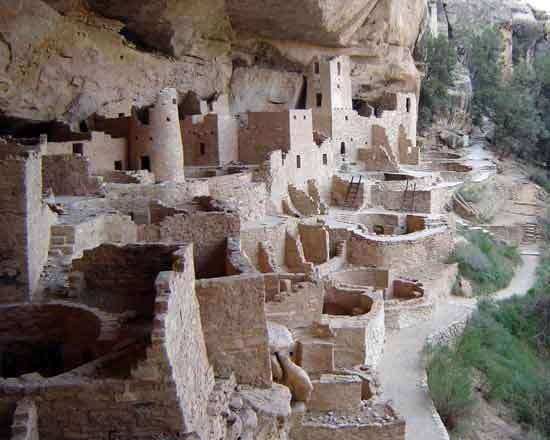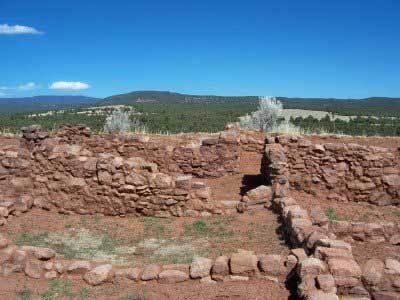Blake de Pastino
Source - http://westerndigs.org/
Despite some recent sensational claims that the prehistoric Southwest was the site of the worst violence in American history, the archaeologist often cited for that assertion says that, in fact, his research shows how some ancient communities successfully avoided violence.
Dr. Timothy Kohler, an archaeologist at Washington State University, says his team’s research uncovered clues as to why some Ancestral Pueblo communities were able to endure hard times while remaining more peaceful than others around them.
Still, a few news outlets, all working off the same press release, drew different conclusions.
“One article I saw suggested that we called the period from A.D. 1140-1180 in the central Mesa Verde[region] ‘the bloodiest per capita years on North American soil.’ Of course we never said anything remotely like that,” Kohler said in an interview.

The Cliff Palace at Mesa Verde
Instead, Kohler’s study spanned nearly 1,000 years of growth and change among the Ancestral Puebloans, comparing human remains found in two of the densest population areas in the pre-contact Southwest: the central Mesa Verde region in southern Colorado, and the northern Rio Grande, in what’s now north-central New Mexico.
Analyzing samples dating back as far as the 600s to as recently as the 1600s, the researchers looked for two key indicators of hand-to-hand combat: cranial trauma, indicating blunt-force attacks; and injuries to the arm bones, typically viewed as defensive wounds.
Then, the team plotted those findings against other key data, including regional changes in population size, and the potential productivity of maize, a key staple crop, in order to provide “additional context” for the brutality revealed by the bones.
“Most earlier studies … were either more interested in explaining conflict than in explaining its absence, or were simply trying to reconstruct what actually happened, rather than trying to explain why it happened,” Kohler explained.
“We tried to show the long-term regional patterns of intensity of violence in two different areas, and how these patterns were related to regional population size and levels of [maize] production.”
Their results showed that southwestern Colorado saw spikes in brutal violence in the mid-12th century, largely because of dramatic political upheaval.
Specifically, they found surges in conflict between 1060 and 1100, and again from 1140 to 1180 — periods that coincide with Mesa Verde’s pivotal interactions with the cultural epicenter of the Puebloan world: Chaco Canyon.
The first peak likely stemmed from early contact between the two groups, when Mesa Verde first fell under Chaco’s direct influence, Kohler said. The second coincides with the collapse of the entire Chaco system, when the pressures of what would turn out to be a half-century drought caused instability in the Chacoan system that dominated Mesa Verde territory.
“There was a lot of violence in the central Mesa Verde, much of which seemed to be either resistance to Chaco’s initial expansion, or somehow related to the collapse of the original Chacoan center in the San Juan basin,” Kohler said.
But again, he noted, there’s nothing to indicate that the conflict was of record-breaking proportions.
“In fact, how could we possibly know that, since studies similar to ours have not been completed in other areas of North America?” he asked.
But aside from these two major cultural events, conflict around Mesa Verde seemed to relate less to politics than to corn production, Kohler said.
Signs of conflict peaked not only when food was in short supply, but also when crops boomed and busted intermittently. Sheer unpredictability seemed to spark conflict as much as scarcity itself.
“In general we see more violence in times of poor maize production, and especially periods when levels of production were highly variable from year to year,” Kohler said.
But the team’s research also found that settlements within just a few days’ travel of Mesa Verde, in the Northern Rio Grande, remained relatively peaceful while experiencing similar pressures — a testament, the researchers say, to the political, economic, and religious structures that helped hold those communities together.
“On the happier side, there’s good evidence that levels of violence in the northern Rio Grande were subsiding by the 1200s and remained relatively low through time,” Kohler said.
Both regions underwent major “baby booms” made possible by the advent of agriculture, he noted, and both experienced the same unnerving variability in corn crops.
But in addition to those pressures, many experts believe that, in the late 1100s, the northern Rio Grande also absorbed waves of immigrants fleeing the drought and bloodshed of Mesa Verde.
And yet, the study’s results show, violence actually declined in the upper Rio Grande from the mid-1100s until the arrival of the Spanish in 1540, even as their population grew.
The anthropologists attribute this to a number of social structures in the northern Rio Grande that seemed to foster unity.

South Pecos Pueblo in the Northern Rio Grande region
For example, many of the pueblos’ religious functions, and the political duties that went with them, became spread out across several settlements, forming multi-pueblo “medicine societies” that helped bind the communities together.
“Things began to change in the northern Rio Grande,” Kohler said. “Small ‘family’ kivas were lost, and the remaining kivas served larger groups of people.”
Similarly, pueblos began to engage in more trade, and to specialize in the goods they made, which meant communities had to rely on each other more.
“Some households slowly began to specialize their production — instead of everyone doing approximately the same mix of hunting and farming, eventually we have households and even pueblos specializing in making of ceramics or in collecting and initially reducing obsidian for tools,” Kohler said.
“These materials had to be traded to make this specialization work, and this trade likely helped smooth inter-Pueblo relationships.”
The regional economy also became more stable in the 1300s, after Rio Grande pueblos developed ways to manage water supplies, smoothing out those drastic variations in corn crops.
In the end, the team concludes, the larger lesson from the ancient Southwest may be found less in the spikes in violence around Mesa Verde than in its later decline among the people of the northern Rio Grande.
“If we accept the notion that many of the people leaving the central Mesa Verde ended up in the Northern Rio Grande, then we realize that these societies must have developed ways to defuse this violence,” Kohler said.
“The tendencies for more violence in periods of low or variable maize production evident in the central Mesa Verde do not exist in the northern Rio Grande.”
Kohler and his colleagues report their findings in the latest issue of the journal American Antiquity.
Kohler, T., Ortman, S., Grundtisch, K., Fitzpatrick, C., & Cole, S. (2014). The Better Angels of Their Nature: Declining Violence through Time among Prehispanic Farmers of the Pueblo Southwest American Antiquity, 79 (3), 444-464 DOI: 10.7183/0002-7316.79.3.444